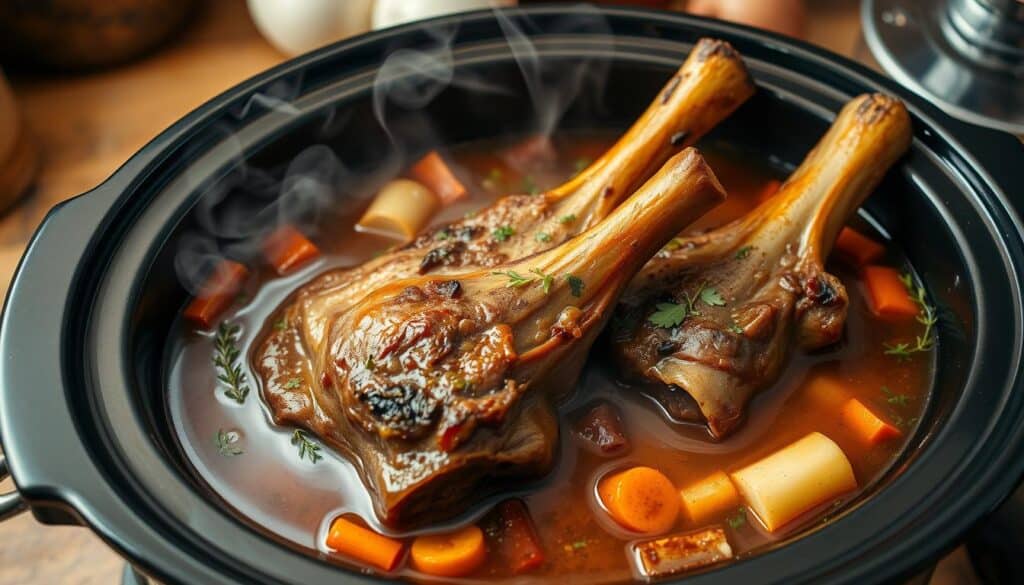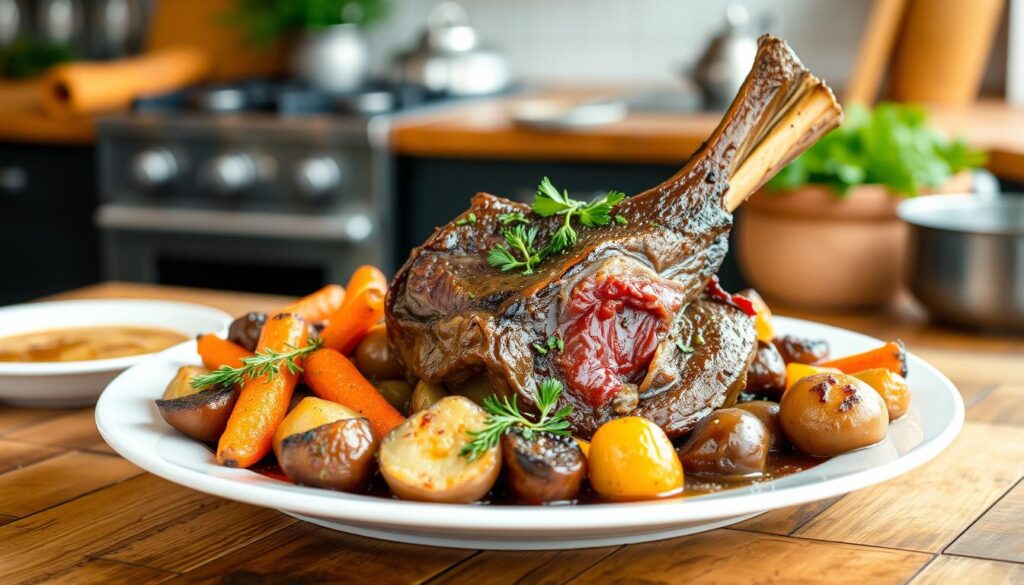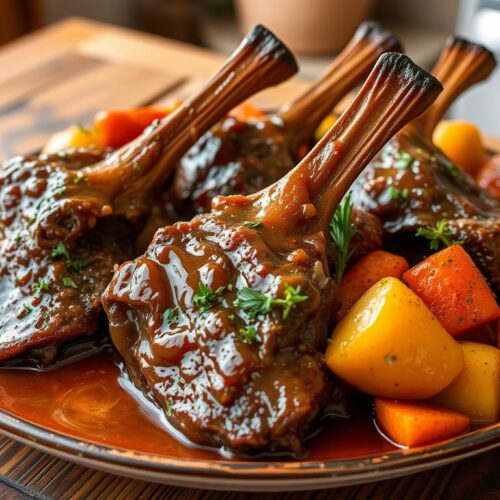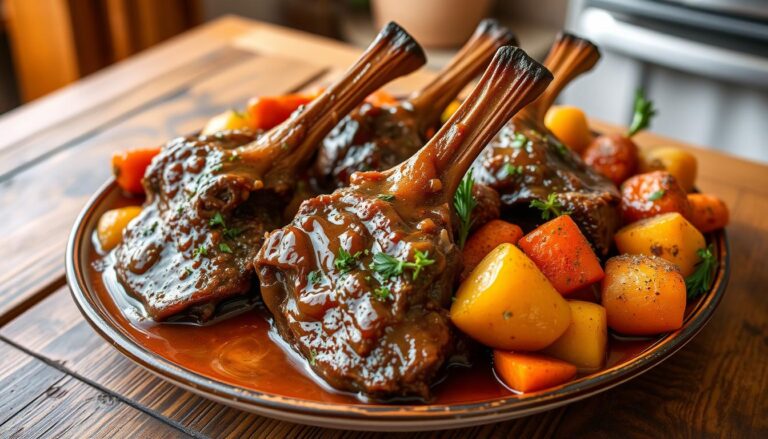Beef shanks might not be the first choice at the butcher shop. Yet, this savory beef shank recipe turns that around. It’s budget-friendly. In a slow cooker, beef shanks become a dish full of comfort. When it’s cold, beef shank stew not only warms you up. It also brings together tastes that are rich and delightful.
Beef shanks are not just tasty. They’re good for your health, fitting well into diets that avoid gluten or carbs. The trick is in slow braising. This method brings out the goodness of collagen and marrow. Such cooking makes the meat tender. It’s hard to resist such deliciousness.
Get ready to dive into a cooking adventure. It will make your taste buds happy and add a great recipe to your collection. This dish is not just filling; it’s good for you too.
Key Takeaways
- Discover how a beef shank recipe can become the star of your dining table.
- Learn why beef shanks are ideal for slow cooking, perfect for hearty stews and braises.
- Understand the health benefits of incorporating beef shank into your diet.
- Unlock the secrets to preparing beef shanks that are both tender and flavorful.
- Get tips on choosing the best beef shanks and preparing them for maximum taste and tenderness.
Why Beef Shanks Deserve Your Attention
Braised beef shanks are less known but amazing. They are full of flavor and good for you. They’re cheap and make your meals better.
The Nutritional Benefits of Beef Shank
Beef shank is full of protein and minerals. It’s great for your health. It’s also low in carbs and has no gluten. This makes beef shanks good for many diets.
Check out tasty beef recipes here. They’re not only delicious but also full of important nutrients. And they fit well with many diets.
Choosing the Best Beef Shanks for Your Recipe
Look for a bone-in beef shank with good marbling. This marbling is key. It makes the meat tender and tasty after cooking by melting the fat right in.
| Feature | Importance |
|---|---|
| Marbling | Enhances flavor and tenderizes the meat during cooking |
| Bone-in Cut | Contributes richer flavor and nutrients from the bone during the cooking process |
| Meat Color | A fresh red color indicates good oxygenation and freshness |
Picking the right meat is key to a great meal. Braised beef shanks will make your dinner special.
Essential Ingredients for a Flavorful Beef Shank
To make your beef shank osso buco or beef shank pot roast outstanding, you need certain key ingredients. This guide focuses on enhancing the rich flavors of beef shanks in red wine. You’ll find tips on essential components for a winning meal. Learn more about layering flavors from related recipes.
Beef Shanks: Choose thick cuts with good marbling. These are vital for delicious osso buco and pot roasts.
Aromatics: Onions, celery, and carrots make up the classic mirepoix. This adds depth to your sauce.
Liquids for Braising: Quality broth mixed with white wine makes the beef tender. Also, use red wine for a deeper taste. Pick a wine that goes well with rich meats.
Tomatoes: Crushed or diced tomatoes add a rich texture. They also brighten up the braising liquid.
Herbs and Spices: Don’t forget fresh thyme and bay leaves. They provide wonderful aromas that match beef perfectly.
Olive Oil: Use it for searing the beef. It helps trap in flavors and adds a light fruity touch.

Combining these ingredients properly is key for delicious beef shanks in red wine. Selecting and sourcing them well brings sophistication. It’s perfect for a cozy dinner or celebratory event.
Preparation Tips for the Perfect Beef Shank Recipe
To kick off your beef shank recipe the right way, there are a couple of key steps. These steps make sure your dish is packed with taste and has the best texture. Proper prep of beef shanks lets the deep, delicious flavors come out during cooking. This ensures a tender beef shank recipe result.
Drying and Seasoning for Maximum Flavor
First, make sure to dry your beef shanks well. Use paper towels to pat each piece dry, removing any extra moisture. This step is crucial for a good sear. Then, tie the beef to the bone with kitchen twine to keep its shape while it cooks. Season well with salt and pepper, and you can lightly dust with flour. This adds taste and helps make the sauce thicker later.
Browning Meat to Develop Deep Flavors
Browning is the secret to pumping up the taste in your beef recipes. Heat top-notch olive oil in a heavy skillet over a medium-high flame. Then, brown the beef shanks till they’re evenly browned on every side. This important step builds a rich base that fills the whole dish with strong, meaty flavors. It’s a must for a standout beef shank recipe.
A Step-by-Step Cooking Guide for Beef Shank Recipe
Making a tasty beef shank stew in your slow cooker follows specific steps. We’ll show how to prepare beef shanks that are tender and flavor-packed.

- Begin by seasoning your beef shanks with salt, pepper, and a sprinkle of dried herbs. Sear them in a hot pan until each side forms a crust, creating a rich base for flavors.
- Transfer the browned beef shanks to your slow cooker. In the same pan, add chopped onions, carrots, and celery to sweat and soften, absorbing the meaty flavors left behind.
- Once the vegetables have softened, pour in a generous splash of white wine to deglaze the pan, scraping up any brown bits. This step is crucial for layering flavors.
- Add the vegetable and wine mixture over the shanks in the slow cooker. Include a rich beef broth, a few cloves of garlic, and additional herbs for a robust base.
- Cover and set your slow cooker on a low heat setting for 8 to 10 hours, allowing the beef shank stew to simmer gently, melding the flavors together into a succulent dish.
Slow cooking makes the beef shank tender, mixing with the broth and veggies’ tastes.
| Ingredient | Quantity | Preparation |
|---|---|---|
| Beef Shank | 4 large pieces | Seasoned and seared |
| White Wine | 1 cup | Used for deglazing |
| Vegetables (onions, carrots, celery) | 2 cups chopped | Sautéed in pan after meat |
| Beef Broth | 4 cups | Added to slow cooker |
By following these steps and using your slow cooker, making an amazing beef shank recipe becomes easy. This ensures a memorable and delicious meal.
Mastering the Art of Braising Beef Shanks
Braising beef shanks makes them very tender, showing the true taste of beef. It’s a slow cooking method with flavorful liquid. This makes dishes like beef shank osso buco or braised beef shanks unforgettable.
Creating a Rich and Hearty Braising Liquid
The liquid you braise in is key. Mixing beef broth with a quality white wine works great. Tomatoes add acidity and richness. While rosemary, thyme, and a bit of garlic give deep flavors.
Braising is not just about texture. It also mixes beef’s nutrition into the liquid. This way, nutrients stay in the dish, making it healthy. Learn how brining can make meats tender and juicy here.
Low and Slow: The Secret to Tender Beef Shanks
Cooking beef shanks slowly at low heat makes them soft. This method lets tough fibers break down. Your meat becomes fork-tender and full of flavor.
Patient cooking with controlled temperature is crucial. This makes sure the beef cooks well without drying out the liquid. It takes hours, so keep an eye on it.
With the right techniques, every bite of your beef shank dish will be tasty and healthy. It celebrates beef’s nutrition and your cooking skills.
Beef Shank Recipe: Bringing the Ingredients Together
Creating a tasty beef shank recipe means mixing ingredients just right. Searing the beef shank adds flavor and gets it ready for slow cooking. This is key for a great beef shank stew. Below, we will talk about how each part makes the dish better.

After searing the beef shank, we sauté vegetables. Onions, carrots, and celery are used. They add layers of flavor. These veggies are mixed with the beef shank, readying it for a delicious pot roast.
- Thyme and bay leaves add herb flavors that match the beef perfectly.
- Using both broth and wine helps to soften the beef over time, blending the flavors well.
In this slow cook, every ingredient turns a tough beef cut into something soft and tasty. This approach works whether you’re making a beef shank pot roast or stew. The key is in how the ingredients and cooking steps come together for a great meal.
| Ingredient | Role in Dish | Cooking Tip |
|---|---|---|
| Beef Shank | Foundation of the dish | Sear until golden-brown for enhanced flavor |
| Onions, Carrots, Celery | Adds depth and sweetness | Sauté before combining with beef |
| Thyme and Bay Leaves | Infuses herbal aromatics | Add early to release flavors during cooking |
| Broth and Wine | Creates the braising liquid | Use a blend for balanced flavor and tenderization |
Combining these ingredients properly is about more than just a recipe. It’s about crafting a dining experience. As the beef cooks slowly, flavors and textures unite in each bite. This detail-oriented process ensures the dish is not just filling but also a feast for the senses.
How to Achieve Fork-Tender Consistency
Mastering a tender beef shank recipe means getting it fork-tender. It’s all about the right cooking techniques and knowing how beef’s nutrition affects its cooking. Check out the nutritional qualities of beef for better results.
Slow cooking lets the beef shank’s tight muscles soften. This makes every bite super tender. Let’s go over the steps and tips to nail this texture:
- Season the beef shank well. It boosts flavor and helps keep the meat moist.
- Brown the beef shanks to get a rich crust. It adds flavor to your dish.
- Slowly braise the beef in a covered pot with liquid and savory veggies and herbs.
- Keep the heat low, around 300°F. Cook for several hours but watch it to prevent drying.
To get the beef shanks perfectly tender, aim for an internal temperature of 160°F. But, the best test is the fork test. If it separates easily from the bone, it’s perfect.
| Cooking Technique | Temperature | Duration | Outcome |
|---|---|---|---|
| Browning | High Heat | 5-7 minutes per side | Rich, caramelized crust |
| Braising | 300°F | 3-4 hours | Fork-tender, falls off the bone |
Being patient is crucial when cooking beef shanks. Letting the connective tissues soften fully is key. Keeping an eye on the heat is also important. Enjoy cooking and the tasty result!
The Perfect Pairings: Serving Suggestions for Beef Shanks
Planning a meal with a beef shank recipe? Choose the right side dishes and wines. This will take your meal from just dinner to a fantastic food journey. Good pairings bring out the rich, deep flavors in dishes like beef shank osso buco or a beef shank stew.
Choosing Side Dishes to Complement Beef Shank
Slow cooker beef shanks are robust. Pair them with sides that blend with the meat’s texture and juices. Creamy polenta, buttery mashed potatoes, or a vibrant risotto work great. These choices complement the beef shanks’ richness and utilize the savory braising liquids.
- Creamy cauliflower mashed potatoes
- Rich polenta
- Aromatic risotto
Wine Pairings for a Gourmet Beef Shank Experience
Choosing the perfect wine enhances the dish’s flavors. A light-bodied red wine is ideal for beef shank osso buco and its tomato sauces. For beef shank stew, a fruity red wine is best. It balances the dish’s heartiness.
Make your evening special with wine pairings from our guide on beef shank osso buco. These pairings enhance both casual and festive meals. Your meal will be unforgettable.
Storing and Reheating Your Beef Shank Creation
After enjoying a tasty meal from a beef shank recipe, it’s important to store and reheat it correctly. This ensures the dish stays delicious. Whether you chose slow cooker beef shanks or a traditional beef shank pot roast, these tips will help. They keep your meal as good as new for days.
First, let your beef shanks cool off before you store them. Then, put them in a shallow airtight container for the fridge. They’ll stay fresh for up to five days. Want to keep them longer? Freeze them for up to two months.
Ready to eat your beef shanks again? There are several ways to warm them up. You can microwave them with a wet paper towel for a quick option. But for the best taste, slowly heat them on the stove. Use their juices or some broth for the best flavors.
Looking for new ideas on storing and reheating meats? Check out these recipes. They focus on keeping meat tender and tasty.
Experimenting with Variations on the Classic Beef Shank Recipe
Exploring the beef shank recipe offers ways to make it your own. You can spice things up. Or you can make changes for dietary needs. Either way, you’ll give a fresh spin to this beloved dish.
Beef recipes pair well with many herbs and spices. You can change the traditional recipe into something special. And it’s all thanks to the different flavors you choose.
Incorporating Different Herbs and Spices
- Rosemary – Adds a woodsy, aromatic lift, perfect for enhancing the deep flavors of beef.
- Thyme – With its subtle earthy tones, thyme complements the robustness of the beef shank.
- Sage – Known for its slight peppery flavor, it introduces a fresh dimension to the beef.
Adapting the Recipe for Various Dietary Needs
Adjusting the beef shank recipe for dietary restrictions is easy. You don’t have to sacrifice flavor. Whether you need it gluten-free, low-sodium, or low-fat, there are good options. These keep the dish yummy and nutritious.
| Ingredient | Traditional Option | Alternative Option | Dietary Adaptation |
|---|---|---|---|
| Flour (for thickening) | All-purpose flour | Cornstarch or almond flour | Gluten-free |
| Broth | Standard beef broth | Low-sodium beef broth | Low-sodium |
| Cooking Oil | Vegetable oil | Coconut oil or olive oil | Healthier fat option |
With different herbs, spices, and smart swaps, you can make a beef shank recipe that suits anyone. This makes it a must-try for any home cook.
Conclusion
We’ve explored the flavorful world of the beef shank recipe. This cut stands out for its rich taste and tenderness. Whether in a beef shank stew or as braised beef shanks, it suits all chefs. The slow-cooking and careful prep reveal beef shanks’ full potential.
Who knew a simple cut could delight our taste buds this way? Beef shank adds nutrition and comfort to meals. It fits well in everyday eats and special feasts alike. Following simple steps, anyone can make this dish shine.
We encourage cooks and food lovers to try braised beef shanks. Play with flavors and discover its many delights. With proper storage, enjoy your creations for days. We hope this article makes you confident in cooking beef shanks. Let it bring excellence to every meal.
FAQ
What are the best cuts of beef shank for braising?
Look for beef shanks that are 2-3 inches thick. They should have good marbling. This helps the fat melt well, making the meat tender and flavorful.
How do I prepare beef shanks before cooking?
First, dry the beef shanks with paper towels. Then season them with salt and pepper. If you want, coat them in flour. Next, brown the shanks in olive oil. This step brings out rich flavors before you start the main cooking process.
What ingredients are essential for a flavorful beef shank recipe?
Important ingredients are bone-in beef shanks, onions, and celery. You’ll also need carrots, tomatoes for the sauce, and broth. Don’t forget white wine for deglazing and herbs like thyme and bay leaves.
Can beef shanks be cooked in a slow cooker?
Yes, you can cook beef shanks in a slow cooker. Just brown them first. Then put them in the slow cooker with your other ingredients. Let them cook slowly until they’re perfectly done.
How long should beef shanks be cooked to achieve tenderness?
Beef shanks need several hours of cooking on low heat. They should be fork-tender and separate easily from the bone. The internal temperature must reach at least 160°F.
What side dishes pair well with braised beef shanks?
Try creamy sides like cauliflower mashed potatoes, polenta, or risotto. They match the rich texture of braised beef shanks well. Use the cooking liquid as a gravy to add even more flavor.
What wines pair well with beef shanks?
If you used white wine in the cooking, go with a light-bodied white wine. For beef shanks braised in red wine, pick a dry red wine. It complements the deep flavors well.
How should I store and reheat leftover beef shanks?
Keep leftovers in an airtight container in the fridge for up to five days. You can freeze them for two months. Reheat them gently in a pan or microwave to keep them tender and tasty.
How can I adapt beef shank recipes to meet dietary needs?
To fit the recipe to specific diets, use gluten-free flour or different broths. Feel free to add various herbs and spices that you like.
What are the nutritional benefits of eating beef shank?
Beef shank is rich in protein. It’s naturally gluten-free and low in carbs. This makes it a great choice for those watching their diet or with specific food needs.
Can I make beef shank osso buco?
Absolutely! Beef shank is perfect for osso buco. It’s slowly braised with aromatic vegetables and broth. Usually, it’s served with gremolata on top.
How do I achieve a rich braising liquid for beef shanks?
To get a rich braising liquid, mix beef broth, wine, and tomatoes. Add the caramelized aromatics. Let everything simmer slowly. This creates a complex and tasty base for the beef shanks.
What makes beef shanks unique for a stew or pot roast?
Beef shanks bring a deep flavor and a tender texture to stews and pot roasts. The marrow in the bone adds something special when the meat is braised slowly.
Source Links
- https://keytomylime.com/beef-shank-recipe/ – BEST Tender Beef Shank Recipe {How to Cook Beef Shank VIDEO} – Key To My Lime
- https://thebigmansworld.com/beef-shank-recipe/ – Beef Shank Recipe {Fall-Off-The-Bone} – The Big Man’s World ®
- https://stemandspoon.com/braised-beef-shanks-oven-recipe/ – Braised Beef Shanks (Oven Recipe) – Stem and Spoon

Tender Beef Shank Recipe
Equipment
- Dutch oven or large pot with a lid
- Tongs
- Large skillet
- Measuring cups and spoons
- Wooden spoon
Ingredients
- 4 Beef shanks about 1.5 inches thick
- 2 tbsp Olive oil
- Salt and pepper to taste
- 1 Large onion chopped
- 3 Carrots chopped
- 3 cloves Garlic minced
- 2 cups Beef broth
- 1 cup Red wine optional, for extra depth of flavor
- 1 15 oz can Diced tomatoes
- 2 tbsp Tomato paste
- 1 tsp Dried thyme
- 1 tsp Dried rosemary
- 2 Bay leaves
Instructions
- eason and Sear the Beef Shanks: Season the beef shanks generously with salt and pepper. Heat olive oil in a large skillet over medium-high heat. Sear the shanks on all sides until browned, about 4-5 minutes per side. Transfer the shanks to a Dutch oven or large pot.
- Sauté the Vegetables: In the same skillet, add the chopped onion, carrots, and garlic. Sauté for 3-4 minutes until the vegetables are softened.
- Deglaze the Pan: Add the red wine (if using) to the skillet, scraping up any browned bits from the bottom of the pan. Cook for 2-3 minutes to reduce slightly.
- Add the Liquids and Seasonings: Pour the beef broth, diced tomatoes, tomato paste, thyme, rosemary, and bay leaves into the Dutch oven with the shanks. Add the sautéed vegetables and stir to combine.
- Slow-Cook the Beef Shanks: Cover the pot and simmer on low heat for 2-3 hours, or until the beef shanks are fork-tender and the sauce is rich and flavorful. Alternatively, you can bake in a preheated oven at 325°F (165°C) for 2-3 hours.
- Serve: Remove the bay leaves and discard. Garnish the beef shanks with fresh parsley and serve hot with mashed potatoes, polenta, or crusty bread.



